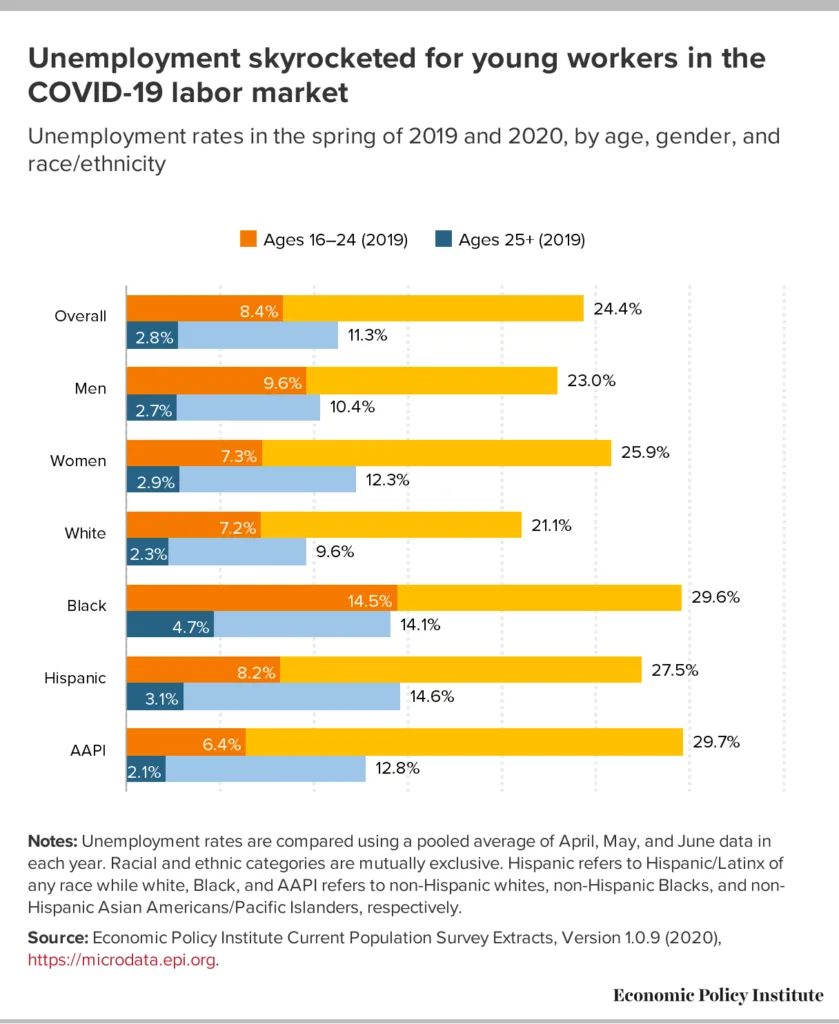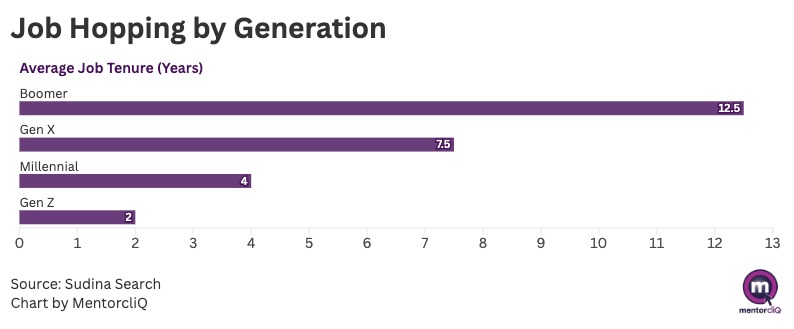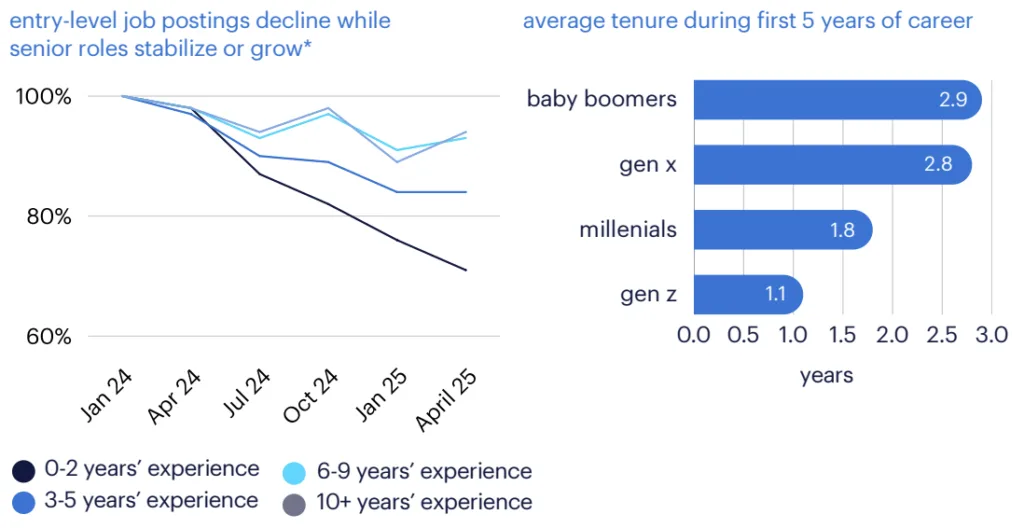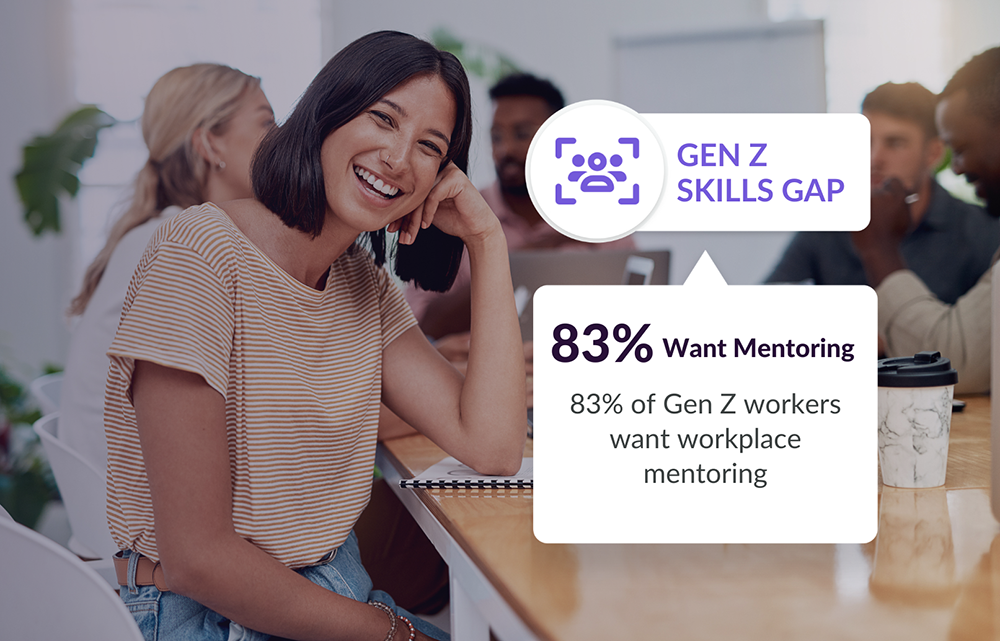Mentoring Gen Z is not a new concept. We’ve already written about the value and strategies tied to mentoring Gen Z workers. However, the upcoming generation of workers is staring down an impending skills and career development gap, the likes of which we have never seen before. Some of it’s because of AI. Some of it’s because of worldwide events and economic conditions beyond their control. But the stage is being set for Gen Z to take its place within businesses without the benefit of experiential skill development, career development, or workplace preparation that their predecessors enjoyed.
This is where mentoring comes in, and where the imperative is strong. Gen Z workers are projected to be the majority of the workforce by 2035. If businesses don’t create structured, human-focused development pathways now, they’ll not only contribute to a leadership and skills gap crisis for themselves in the years to come, but also hinder their ability to attract and retain top talent. They’re also hurting their present-day leadership pipeline as Gen Z worker turnover accelerates for a generation that’s hyper-focused on personal and professional development at all costs.
This trend is part of our 3-part National Mentoring Month series on mentoring trends for 2026. We recommend you read our other two trends posts:
Gen Z’s Unprecedented Skills Gap Goes Back to the Pandemic
Gen Z workers are facing down a development gap that’s becoming increasingly difficult to bridge. The data on this is pretty straightforward, and it’s difficult to completely blame that lack of experience on their age. A confluence of factors has come together that’ve led to a notable loss of growth opportunities for Gen Z workers in both soft and hard skills.
And the pandemic bears the brunt of the blame.
Job, lifestyle, and early career disruptions caused by the pandemic have resulted in significant delays for Gen Z in five core areas:
- Soft skills acquisition, particularly in communication
- Domain-specific hard skills acquisition
- Internal company knowledge required for promotions
- Critical early-career networking
- Junior-level career development and career pathing
While the vast majority of Millennials, Gen X, and Boomers were temporarily, although harshly, affected by the COVID-19 pandemic, the Economic Policy Institute reported in 2020 that the pandemic recession had a deep and negative impact on younger workers. Job losses were high for nearly everyone, but most workers in the more established workforce age ranges recovered quickly.
However, Gen Z workers faced an exceptionally uphill battle. Around 24 million people within that generation were between the ages of 18 and 24 and just entering the workforce when COVID-19 hit. Job losses often came for them first.

And it makes sense. During periods of economic uncertainty, employers become exceedingly risk-averse. This also spills over into their people strategy. More experienced workers come at a higher cost, and many face layoffs during such times; however, younger workers often come with fewer skills that help maintain and increase profitability.
In effect, younger, less-experienced workers tend to be a cost center until they’ve ramped up to becoming a contributing team member. That can take anywhere between 6 and 12 months (sometimes more, depending on the complexity of the role).
Enboarder offers up a formula to calculate the cost to ramp up productivity:
Lost Productivity Cost = (Target Productivity – Actual Productivity) x Average Monthly Revenue per Employee x Number of Ramp-Up Months
Don’t worry, we turned it into a calculator you can use to test this out yourself:
Lost Productivity Cost Calculator
Calculate the true cost of productivity gaps
Thus, companies tend to both retain and hire workers who already possess the necessary skills, instead of hiring younger and less skilled individuals who require more time to develop those skills. The potential risks from hiring greenhorns lead companies to opt for more experienced workers who require minimal onboarding.
As noted by the Federal Reserve Bank of Richmond:
“A firm’s hiring decisions depend on how it values potential workers — specifically, the present discounted value of a worker’s future contributions to the firm profits. If this valuation fluctuates significantly, firms might dramatically reduce job postings during recessions as the perceived value of new hires declines.”
The pandemic created a hiring disaster for Gen Z workers. This was further complicated by the overhiring and then mass layoffs that followed soon after the (very brief) Great Resignation period between 2021 and 2023 when workers had the upper hand.
Entry-level roles are essential for career and skill development. But nearly a third of Gen Z workers faced an uphill battle during their most critical time on the job market, with the remainder continuing to struggle amidst a seemingly never-ending run of recessionary fears dictating hiring practices.
Gen Z Workers Are Desperate to Play Catch Up, and It’s Making Them Impatient
Millennials used to get a bad reputation in the media for job hopping. Then Gen Z hit the scene. The upcoming generation has the fastest job-hopping rate of any generation before it. Data from Sudina Search shows that Gen Z employees stick around for an average of 2 years, compared to 4 years for Millennials, 7.5 years for Gen X, and 12.5 years for Boomers.
Those numbers look even worse when you compare the first 5 years of a career across generations. Gen Z only sticks around for just over 1 year, according to Randstad.

I can hear the excuses now:
“That’s always been true of young workers.”
“Gen Z is just impatient.”
“They’ll get over it.”
These are only true to an extent — and a very short one at that. Everything we explained in the section above has incredibly impacted Gen Z workers’ behaviors and attitudes toward work. Impatience is a perfectly legitimate response to experiencing delays in your promised career and skill development in a manner far beyond your control.
Gen-Z workers are getting the short end of the stick
The data backs this up, as well.
According to VeryWellMind, Gen Z is the most stressed-out generation, with over 60% reporting that their mental health was “less than good” in the past month. This is backed up by data from a 2021 survey by AP NORC, which found that pandemic life took its toll on Gen Z-ers, with 46% stating that the pandemic made pursuing educational and career goals more difficult.
Unfortunately, little changed, and companies continued to reduce the number of entry-level roles they posted, while opting instead to shop around for (and wait longer to find) workers with more years of experience.
The 2025 report from Randstad paints a sobering picture: Between January 2024 and April 2025, entry-level job postings declined by 25%. Even postings for individuals with 3-5 years’ experience (again, mostly hitting Gen Z, but elders in the generation) declined and continue to decline. Job postings for those with 6 years’ experience or more (very few Gen Z workers fit this criterion; only those who started their careers between when they were between 18 and 22 in 2019 meet that minimum) fell by around 10% and have mostly stabilized.

To paint that picture for you:
- In the US alone, there are around 71 million people in Gen Z
- One-third of Gen Z were in the workforce during the pandemic years, and were the most impacted by job losses
- As of 2025, Gen Z makes up about 18% of the workforce, or about 30 million people (about 40% of Gen Z).
- The vast majority of adult Gen Z workers have never experienced a stable economy or a generous labor market
- Gen Z workers are now staring down the evaporation of entry-level roles, leaving many grasping for straws when it comes to career and skill development
The issue isn’t that Gen Z workers are lazy, impatient, or socially awkward. The issue is that circumstances beyond their control have made them that way, and they’re doing whatever they can to accelerate their growth in a labor market that’s increasingly built around an unforgiving and uncharitable philosophy of “I got mine.”
Mentoring Offers Gen Z an Accelerated Growth Pathway
Leaders have been complaining about Gen Z in multiple ways, but it comes down to two key areas:
- Their current technical and soft skills don’t translate to workplace readiness
- Their expectations mismatch is creating a revolving door
Gen Z workers want to learn. But too many workplaces aren’t emphasizing the kind of employee development that’s best suited for a generation that spent many of its formative years alone at home during a pandemic.
Mentoring Gen Z workers solves this problem by working as a bridge between company needs and Gen Z workers’ incredible potential and strong desire for growth.
Why Traditional Development Approaches Are Failing Gen Z
Before we talk about the solution (mentoring), let’s acknowledge why current approaches aren’t working.
In our AI upskilling trend post, we mentioned how 46% of employees speed up training videos or multitask while playing them. For Gen Z, that number is likely even higher. They’ve grown up with YouTube’s 2x playback speed. They’ve been multitasking since middle school. Traditional e-learning doesn’t just bore them—it literally doesn’t register.
More than anything else, however, Gen Z are social learners, according to GenHQ’s 2018 State of Gen Z report. Around two-thirds of Gen Z workers (66%) want regular feedback from their managers. They want to learn through someone helping them along, rather than through self-guided activities.
Mentoring is by far one of the best ways to accomplish this. According to Adobe, 83% of Gen Z workers want mentoring at work, but only around half report having a mentor. That gap in what they need for skill and career development and what they’re actually getting results in the “impatience” many leaders ascribe to the generation.

The “sink or swim” approach that worked for previous generations is drowning Gen Z. Without the informal support networks that used to exist in physical offices, being thrown into the deep end just results in them swimming to a different pool entirely. (Perhaps one of your competitors that DOES offer mentoring?)
Mentoring Is the Bridge Between Gen Z Potential and Business Success
Here’s where mentoring becomes not just helpful, but essential. And we’re not talking about those dusty, formal mentoring programs where you meet quarterly to discuss “career goals.” We’re talking about dynamic, human-centered mentoring that actually addresses Gen Z’s unique needs and leverages their unique strengths.
Mentoring works for Gen Z skill development for three critical reasons:
1. Mentoring Gen Z provides the human connection they desperately need
When a Gen Z employee has a mentor, they’re not just learning skills; they’re also gaining valuable insights. They’re building a relationship. They’re finding an advocate. They’re developing the kind of loyalty that makes them think twice before jumping to the next opportunity.
We’ve seen this first-hand among MentorcliQ customers that provide mentoring programs for all employees, and those that provide programs and ERGs targeted to young employees. Mentoring and community learning through MentorCliQ result in an average 43% increase in retention among participants.
These workers report higher job satisfaction, better skill development, and more substantial commitment to their organizations. The mentoring relationship becomes the anchor that keeps them engaged and growing.
2. Mentoring Gen Z delivers learning in a format they accept
Gen Z doesn’t want to be talked at; they want to have real, authentic career conversations. Don’t hand them theoretical ideas. Instead, give them hands-on experiences. And while you can keep doing those annual reviews, don’t make those substitutes for the continuous feedback they want; that’s easily and organically attainable through mentoring.
Instead of watching a video about “professional communication,” a Gen Z mentee can practice drafting emails with their mentor and get immediate feedback. Rather than reading about leadership, they can shadow their mentor in meetings and debrief afterward. Instead of wondering if they’re on the right track, they get regular, specific guidance.
This isn’t accommodation—it’s optimization. We’re meeting Gen Z where they are and helping them get where they need to go in the most efficient way possible.
3. Gen Z mentoring creates the knowledge transfer mechanism companies desperately need
Knowledge hoarding has long been a problem at many organizations. Particularly now that companies prefer to hire experienced workers instead of training new hires, that hoarding is becoming even worse. Yet companies ultimately need younger workers to replace their existing workers. That means internal knowledge MUST be transferred, or the risk of significant business disruption increases.
Mentoring solves this problem. When you pair experienced employees with Gen Z workers in structured mentoring relationships, you create a safe, trusted environment for knowledge transfer.
The mentor isn’t just training a potential job-hopper. Gen Z workers are more likely to stay when they’re getting skill and career development. They’re investing in a specific person they’ve come to know and care about. The mentee isn’t just extracting information—they’re learning from someone they respect and want to emulate.

This bi-directional relationship also benefits mentors. Gen Z mentees bring fresh perspectives on technology, social trends, and emerging markets. They challenge assumptions and push for innovation. The mentor learns as much as they teach, keeping them engaged and preventing the stagnation that often precedes retirement.
Managers can fill this gap easily. Half of Gen Z workers believe managers should provide mentoring, and 59% believe they should offer guidance and support—far fewer report experiencing that in their work experiences.
But mentoring is not just a job for managers. Companies must strategically spread this learning out across the organization, pairing individuals in various types of mentoring relationships, including peer-to-peer, reverse mentoring, group mentoring, and mentoring circles.
Building a Gen Z Mentoring Program That Actually Works
So how do you build a mentoring program that closes the Gen Z skills gap? It’s not about forcing old-school mentoring approaches on a new generation. It’s about reimagining mentoring for the reality of today’s workplace.
1. Start with skills-based matching, not hierarchical pairing
Don’t rely too heavily on the traditional model of pairing junior employees with senior executives. Gen Z needs mentors who have specific skills they want to learn, regardless of title or tenure.
Utilize skills assessments and career aspirations to determine what Gen Z employees require to develop. Then find mentors who excel in those areas.
- Maybe it’s a peer who’s brilliant at client presentations.
- Perhaps it’s a mid-level manager who’s mastered project management.
- Or it could be a senior leader who navigates organizational politics with ease.
MentorcliQ’s automated matching can handle this complexity, ensuring each Gen Z employee gets paired with someone who can teach them exactly what they need to know.
2. Embrace multiple mentoring formats
Gen Z thrives on variety and flexibility. Don’t lock them into a single mentoring format. Instead, create a mentoring ecosystem that includes:
- Flash mentoring for quick skill acquisition
- Peer mentoring for collaborative learning
- Group mentoring for broader perspective
- Reverse mentoring, where Gen Z teaches digital skills to senior employees
- Traditional 1:1 mentoring for deep, sustained development
Different skills require different approaches. Learning to use a new software tool may require just a brief mentoring session. Developing executive presence might require months of 1:1 mentoring. Give Gen Z options, and they’ll engage more deeply.
3. Make it social and visible
Gen Z grew up sharing their lives online. They’re comfortable with public learning and peer recognition. Use this to your advantage.
Create mentoring cohorts where Gen Z employees go through the program together. Set up Slack channels where they can share wins and challenges. Host “mentoring showcases” where pairs present what they’ve learned. Make mentoring a social experience, not a private one.
This visibility also creates positive peer pressure. When Gen Z employees see their colleagues growing through mentoring, they want in. When they see mentoring celebrated publicly, they engage more fully.
4. Focus on micro-learning and immediate application
Gen Z has been trained by TikTok and Instagram to consume information in bite-sized chunks. Work with that, not against it.
Structure mentoring around specific, actionable skills that can be learned and applied quickly. Instead of “develop leadership skills” over six months, try “run your first team meeting effectively” in two weeks.
Each mentoring session should have a clear objective, practical application, and an immediate feedback loop. The mentor and mentee discuss a skill the mentee needs to learn, the mentee tries it, they debrief, and then iterate.
This rapid cycle keeps Gen Z engaged and accelerates their development quickly.
5. Track everything and show progress
Gen Z is the quantified generation. They track their steps, their sleep, and their screen time. They want to see their professional development with the same clarity.
Build measurement into your mentoring program from day one. Track skill development, project outcomes, and career progression. Show Gen Z employees exactly how mentoring is accelerating their growth. Create dashboards that show their progress against goals and peers.
This data also helps you prove ROI to leadership. When you can show that mentored Gen Z employees are a certain percent more likely to be promotion-ready, budgets suddenly become easier to secure.
The Reverse Mentoring Bonus: Let Gen Z Teach While They Learn
Here’s a strategy that’s pure gold for closing the skills gap: reverse mentoring. While Gen Z is learning workplace skills from experienced employees, they can teach digital skills, social media strategies, and emerging trends to senior staff.
This isn’t charity work. Gen Z has genuine expertise that your organization needs:
- They understand how to reach younger consumers
- They’re fluent in emerging technologies like generative AI
- They bring fresh perspectives on workplace culture
- They can spot trends before they hit the mainstream
When you position Gen Z as teachers, not just students, something magical happens. Their confidence grows. Their engagement deepens. They feel valued for what they bring, not just criticized for what they lack.
And the senior employees? They’re suddenly learning skills they need to stay relevant. It’s a true win-win that transforms mentoring from a hierarchical exercise into a collaborative exchange.
The Time to Act is Now (And the Window is Closing)
Let’s do some simple math.
I wrote this at the end of 2025. Gen Z will be the workforce majority by 2035. That leaves 9 years to develop a generation that’s currently struggling with basic workplace skills.
Nine years might sound like a long time. It’s not.
It takes 2-3 years for a new employee to become fully productive. Another 3-5 years to develop leadership capabilities. Add in job changes, economic disruptions, and the accelerating pace of change, and that 9-year runway starts looking very short.
Companies that start building robust Gen Z mentoring programs now will have a massive advantage. They’ll have:
- Lower turnover as Gen Z employees feel invested in
- Stronger leadership pipelines as skills gaps close
- Better innovation as diverse perspectives merge
- Preserved institutional knowledge as generations connect
- Higher engagement as human connections deepen
Meanwhile, companies that wait and hope Gen Z will somehow figure it out on their own will find themselves in crisis mode circa 2030. Trying to automate away those entry-level jobs with AI won’t do you any favors when you need to start succession planning and realize you don’t have the internal knowledge and skills developed in the way that was needed for Gen Z to start taking the reins.
The Gen Z Skill Gap Is Solvable (And the Solution Creates a Competitive Advantage)
The Gen Z skill gap is solvable. That’s the optimistic truth. Mentoring solves it very easily, which is the functional truth.
Unfortunately, many companies are drawing back on entry-level roles, which creates a negative talent feedback loop. And those that are hiring entry-level workers are using the current economic situation to excuse cutting development programs (a shortsighted risk to save money but cost talent in the future).
We’re not dealing with an impossible problem. We’re dealing with a generation that wants to learn, grow, and succeed. They just need the right structure and support to do so.
Mentoring provides that structure:
- It creates the human connections Gen Z craves while delivering the practical skills they need.
- It bridges the gap between their digital nativity and the reality of the workplace.
- It transforms job-hoppers into loyal, skilled employees who can carry your organization into the future.
The companies that recognize this opportunity for what it is (a massive talent grab that will reap benefits in less than a decade) will thrive. They’ll build mentoring programs that don’t just transfer skills but transform careers. They’ll create cultures where every generation learns from the one that came before. They’ll transform the skills crisis into a skills advantage.
Platforms like MentorcliQ can automate the matching, track the progress, and scale the impact.
Both Gen Z employees hungry to learn and experienced workers with knowledge to share will latch on when the process is streamlined. All that’s missing is the commitment and technology needed to bring them together.
The clock is ticking. But it’s not too late. Not yet.
With or without you, Gen Z workers will close their skills gap. The companies that invest in their efforts will reap the rewards.




